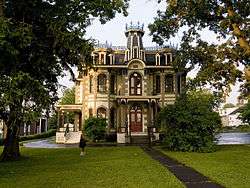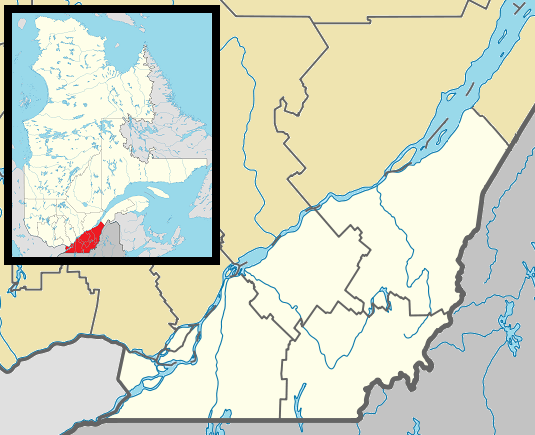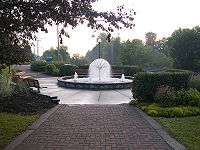Cowansville
Cowansville is a town in south-central Quebec, Canada, located on Lac Davignon 20 kilometres (12 mi) north of the U.S. border. It is the seat of Brome-Missisquoi, a regional county municipality. The population as of the Canada 2011 Census was 12,489.
Cowansville | |
|---|---|
City | |
 Nesbitt House, Cowansville | |
.svg.png) Coat of arms | |
| Motto(s): Fortitudo et decor | |
Location within Brome-Missisquoi RCM | |
 Cowansville Location in southern Quebec | |
| Coordinates: 45°12′N 72°45′W[1] | |
| Country | |
| Province | |
| Region | Montérégie |
| RCM | Brome-Missisquoi |
| Constituted | January 1, 1876 |
| Government | |
| • Mayor | Sylvie Beauregard |
| • Federal riding | Brome—Missisquoi |
| • Prov. riding | Brome-Missisquoi |
| Area | |
| • City | 48.70 km2 (18.80 sq mi) |
| • Land | 46.09 km2 (17.80 sq mi) |
| • Urban | 29.42 km2 (11.36 sq mi) |
| • Metro | 46.09 km2 (17.80 sq mi) |
| Population (2011)[5] | |
| • City | 12,489 |
| • Density | 271.0/km2 (702/sq mi) |
| • Urban | 11,615 |
| • Urban density | 394.8/km2 (1,023/sq mi) |
| • Metro | 12,489 |
| • Metro density | 271.0/km2 (702/sq mi) |
| • Pop 2006-2011 | |
| • Dwellings | 5,789 |
| Time zone | UTC−5 (EST) |
| • Summer (DST) | UTC−4 (EDT) |
| Postal code(s) | J2K 1T4 |
| Area code(s) | 450 and 579 |
| Highways | |
| Geocode | 46080 |
| Website | www |
In recent years, Cowansville has seen its commercial activity blossom mainly due to the fact that there is nothing in the surrounding towns.
History and name

Jacob Ruiter was the first person to settle on the current site of Cowansville. In 1800 he built a flour mill, and then a saw mill. In 1805, Ruiter named the small town as Nelsonville, in honour of British admiral, Lord Horatio Nelson, who was killed in the naval Battle of Trafalgar.
The city's current name is due to Peter Cowan, a merchant from Montreal who settled in the area in 1836 and become postmaster in 1841. In order to avoid the mail being sent inadvertently to another city named Nelsonville, close to Hamilton in Upper Canada, he decided to change its name.
During the 1870s, the construction of the South Eastern Railway linking Montreal to Cowansville and the opening of the first bank, the Eastern Townships Bank, contributed to the expansion of the small city, which allows many businesses settle in the area. The municipality detached from the district of Dunham, and incorporated on the January 1, 1876 and officially was named Cowansville. In February of the same year James O'Halloran was acclaimed as Mayor by the town council. Cowansville saw a strong industrial growth during the 20th century, and became a city on June 25, 1931, and has grown since World War II by various annexations, such as Sweetsburg in 1964.
The municipality has a current population of over 12,000. The main economy is based on the industrial sector, in particular textiles. There is also a hospital, Brome-Missisquoi-Perkins, a municipal court, a federal penitentiary, and a Nature Centre close to Davignon Lake.
Cowansville is the seat of the judicial district of Bedford.[8] It is also the birthplace of the artist and botanist Faith Fyles.
Demographics
Population
| Canada census – Cowansville, Quebec community profile | |||
|---|---|---|---|
| 2011 | 2006 | ||
| Population: | 12,489 (+2.5% from 2006) | 12,182 (+1.2% from 2001) | |
| Land area: | 46.09 km2 (17.80 sq mi) | 46.09 km2 (17.80 sq mi) | |
| Population density: | 271.0/km2 (702/sq mi) | 264.3/km2 (685/sq mi) | |
| Median age: | 45.5 (M: 43.2, F: 47.5) | 43.7 (M: 41.8, F: 45.8) | |
| Total private dwellings: | 5,789 | 5,461 | |
| Median household income: | $43,252 | $41,010 | |
| References: 2011[5] 2006[9] earlier[10] | |||
|
|
|
Language
| Canada Census Mother Tongue - Cowansville, Quebec[11] | ||||||||||||||||||
|---|---|---|---|---|---|---|---|---|---|---|---|---|---|---|---|---|---|---|
| Census | Total | French |
English |
French
& English |
Other | |||||||||||||
| Year | Responses | Count | Trend | Pop % | Count | Trend | Pop % | Count | Trend | Pop % | Count | Trend | Pop % | |||||
2011 |
12,135 |
9,780 | 80.59% | 1,970 | 16.23% | 195 | 1.61% | 190 | 1.56% | |||||||||
2006 |
11,600 |
9,535 | 82.20% | 1,705 | 14.70% | 155 | 1.33% | 205 | 1.77% | |||||||||
2001 |
11,290 |
9,480 | 83.97% | 1,540 | 13.64% | 190 | 1.68% | 80 | 0.71% | |||||||||
1996 |
11,205 |
8,950 | n/a | 79.88% | 1,875 | n/a | 16.73% | 235 | n/a | 2.10% | 145 | n/a | 1.29% | |||||
Notable people
- George Harold Baker (1877-1916), was a lawyer, political figure, soldier and Member in the Canadian House of Commons, as a Conservative Member of Parliament[12]
See also
- List of cities in Quebec
References
- Reference number 15704 of the Commission de toponymie du Québec (in French)
- "Conseil municipal". Ville de Cowansville. Retrieved 15 January 2020.
- Ministère des Affaires municipales, des Régions et de l'Occupation du territoire: Cowansville
- Parliament of Canada Federal Riding History: BROME--MISSISQUOI (Quebec)
- "2011 Community Profiles". 2011 Canadian Census. Statistics Canada. July 5, 2013. Retrieved 2014-03-12.
- 2011 Statistics Canada Census Profile: Cowansville, Quebec (Population centre).
- 2011 Statistics Canada Census Profile: Cowansville, Quebec (Census agglomeration) The census agglomeration consists of only Cowansville itself. In the 2006 census it had also included East Farnham.
- Territorial Division Act. Revised Statutes of Quebec D-11.
- "2006 Community Profiles". 2006 Canadian Census. Statistics Canada. March 30, 2011. Retrieved 2014-03-12.
- "2001 Community Profiles". 2001 Canadian Census. Statistics Canada. February 17, 2012.
- Statistics Canada: 1996, 2001, 2006, 2011 census
- Morning Glory: Canada's own WWI war horse